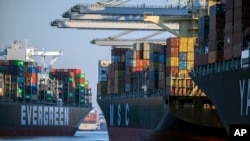ອົງການໆຄ້າໂລກ ຫຼື WTO ທຳນາຍການເຕີບໂຕ ຂອງການຄ້າຢູ່ທົ່ວໂລກຈະຊ້າລົງຢ່າງຫຼວງຫຼາຍຢູ່ທີ່ 1 ເປີເຊັນ ໃນປີ 2023 ຫລຸດລົງມາຈາກການຄາດຄະເນທີ່ສູງ 3.5 ເປີເຊັນ ສຳລັບປີນີ້. ລີຊາ ສະລາຍ ມີລາຍງານໃຫ້ ວີໂອເອ ຈາກນະຄອນເຈນີວາ ກ່ຽວກັບການປ່ຽນແປງໃນການທຳນາຍຂອງການຄ້າໂລກ ຊຶ່ງ ກິ່ງສະຫວັນ ຈຳນຳເອົາລາຍລະອຽດ ມາສະເໜີທ່ານ ໃນອັນດັບຕໍ່ໄປ.
ບັນດານັກເສດຖະສາດຂອງອົງການ WTO ກ່າວວ່າ ການຄ້າໄດ້ມີບົດບາດທີ່ສຳຄັນໃນການເຮັດໃຫ້ເສດຖະກິດໂລກໝູນວຽນຕະຫລອດໄລຍະໃນການເກີດໂຣກລະບາດໂຄວິດ-19. ໃນຂະນະທີ່ການຊື້ຂາຍສິນຄ້າໄດ້ຕົກຫຼຸດລົງທ່າມກາງ ທີ່ມີການລັອກດາວໃນປີ 2020 ພວກເຂົາເຈົ້າໃຫ້ຂໍ້ສັງເກດວ່າ ຫລັງຈາກນັ້ນກໍໄດ້ຟື້ນໂຕຄືນ ເຮັດໃຫ້ໂລກໄດ້ຮັບການສະໜອງອາຫານ ຢາປົວພະຍາດ ແລະສິນຄ້າທີ່ສຳຄັນຕ່າງໆ.
ເຖິງຢ່າງໃດກໍດີ ເຂົາເຈົ້າກ່າວວ່າ ວິກິດການຫລາຍຢ່າງ ຮວມທັງໂຣກລະບາດ ຄວາມຕື່ນຕົກໃຈກ່ຽວກັບດິນຟ້າອາກາດ ແລະສົງຄາມໃນຢູເຄຣນ ຍັງສືບຕໍ່ສ້າງ
ຄວາມລົບກວນ ຕໍ່ຕ່ອງໂສ້ອຸບປະທານ. ນະໂຍບາຍງົບປະມານ ແລະການເງິນ ແລະຄວາມກົດດັນທາງດ້ານເງິນເຟີ້ ເຂົາເຈົ້າໃຫ້ຂໍ້ສັງເກດວ່າ ເປັນສາເຫດໃຫ້ພະລັງງານ ແລະສິນຄ້າຂຶ້ນລາຄາ. ເຂົາເຈົ້າກ່າວວ່າ ບັນດາປະເທດທີ່ກຳລັງພັດທະນາທີ່ມີລາຍໄດ້ຕ່ຳໂດຍສະເພາະ ປະເຊີນໜ້າກັບຄວາມສ່ຽງທີ່ຮ້າຍແຮງ ຈາກການບໍ່ມີຄວາມປອດໄພ ແລະກົດດັນໃນດ້ານໜີ້ສິນ.
ຜູ້ອຳນວນການໃຫຍ່ ຂອງອົງການ WTO ທ່ານນາງໂງຊິ ໂອກົນໂຈ-ອີວິລາ ກ່າວວ່າ ຂົງເຂດສ່ວນໃຫຍ່ມີທ່າທາງວ່າການສົ່ງອອກຈະເປັນໄປໃນທາງບວກ ໃນປີ 2023 ຍົກເວັ້ນແຕ່ອາຟຣິກາ ແລະພາກຕາເວັນອອກກາງ. ທັງສອງຂົງເຂດ ທ່ານນາງກ່າວວ່າ ຈະປະສົບກັບການສົ່ງອອກທີ່ຫຼຸດລົງ. ທ່ານນາງກ່າວວ່າ ຍອດຜະລິດຕະພັນຮວມຫຼື GDP ຂອງໂລກໃນປີໜ້ານີ້ຄາດວ່າຈະຊ້າລົງຫາຢູ່ໃນລະດັບ 2.3 ເປີເຊັນ ຫລຸດລົງເກືອບນຶ່ງເປີເຊັນເຕັມຈາກການຄາດຄະເນຂອງອົງການ WTO ກ່ອນໜ້ານີ້. ທ່ານນາງໂອກົນໂຈ-ອີວິລາ ກ່າວວ່າ:
“ບັນດາຜູ້ອອກນະໂຍບາຍປະເຊີນໜ້າກັບທາງເລືອກທີ່ບໍ່ສະໜ່ຳສະເໝີ ໃນຂະນະທີ່ເຂົາເຈົ້າຊອກຫາທາງເລືອກທີ່ກ້ຳເກິ່ງທີ່ດີທີ່ສຸດ ເພືອມຳການຕໍ່ສູ້ກັບເງິນເຟີ້ ຮັກສາວຽກງານແລະກ້າວເຂົ້າສູ່ເປົ້າໝາຍນະໂຍບາຍທີ່ສຳຄັນເຊັ່ນການຫັນປ່ຽນ ໄປຫາພະລັງງານທີ່ສະອາດ. ການຈຳກັດທາງດ້ານການຄ້າອາດຈະຊັກຊວນໃຫ້
ມີການຮັບມືກັບຄວາມຝືດເຄືອງທາງດ້ານເສດຖະກິດ ແຕ່ສິ່ງເຫລົ່ານີ້ຈະເຮັດໃຫ້ ຄວາມກົດດັນເງິນເຟີ້ເລິກລົງໄປອີກ ແລະຫລຸດລະດັບມາດຕະຖານການເປັນຢູ່.”
ທ່ານນາງໂອກົນໂຈ-ອີວີລາ ກ່າວວ່າ ການຄ້າເສລີ ເຮັດໃຫ່ເສດຖະກິດເຕີບໂຕ ແລະສາມາດຊ່ວຍາບໍ່ໃຫ້ສິນຄ້າຂຶ້ນລາຄາ. ດັ່ງໂຕຢ່າງການສືບຕໍ່ເປີດຕະຫລາດໃຫ້ມີການຂາຍອາຫານ ທ່ານນາງກ່າວວ່າ ຈະເພີ້ມອາຫານອັນສຳຄັນ ທີ່ມີຢູ່ນັ້ນ ແລະຈະຮັກສາຄວາມກົດດັນຕໍ່ລາຄາ. ທ່ານນາງໂອກົນໂຈ-ອີວິລາ ກ່າວວ່າ:
“ວຽກງານສັງເກດການຂອງພວກເຮົາກ່ຽວກັບການຄ້າອາຫານໄດ້ຊີ້ບອກໃຫ້ເຫັນ ເຖິງການຫຼຸດລົງຕໍ່ຂອບເຂດການຈຳກັດ ເພາະສະນັ້ນພວກເຮົາຕ້ອງຮັກສາເປັນຫູເປັນຕາ. ເບິ່ງໄປຂ້າງໜ້າ ຮັບມືທີ່ດີຂຶ້ນ ຕໍ່ຄວາມຫຼໍ່ແຫຼມ ຂອງຕ່ອງໂສ້ອຸບປະທານ ທີ່ມີຂຶ້ນໃນຮອບສອງປີທີ່ຜ່ານມາ ກໍຄືການເສີມສ້າງໃຫ້ມີຄວາມຫຼາກຫຼາຍເພີ້ມຂຶ້ນ ມີຄວາມເຈາະຈົງໜ້ອຍລົງ ສຳລັບການຜະລິດສິນຄ້າ ແລະການບໍລິການ.”
ທ່ານນາງກ່າວວ່າ ຄວາມຫຼາກຫຼາຍຈະຊຸກຍູ້ໃຫ້ມີການເຕີບໂຕທາງດ້ານເສດຖະກິດ ແລະຊ່ວຍເຫລືອໃນດ້ານການປັບໂຕຂອງການສະໜອງສິນຄ້າ ແລະຄວາມໝັ້ນຄົງທາງດ້ານລາຄາ ໃນໄລຍະຍາວ. ທ່ານນາງກ່າວວ່າ ມັນຍັງສາມາດຊ່ວຍແກ້ໄຂບັນຫາທ້າທາຍທາງດ້ານເສດຖະກິດ ທັງໃນປັດຈຸບັນ ແລະໃນອະນາຄົດຕໍ່ໜ້າ.
Growth in global trade flows will be dramatically lower than expected in 2023, according to a report issued Wednesday by the World Trade Organization, as Russia’s invasion of Ukraine and global central banks’ efforts to fight inflation continue to take a toll.
The WTO projected that after expanding at a 3.5% pace in 2022, growth in the trade of goods in 2023 will plunge to just 1%. That’s considerably below the agency’s most recent estimate from April, which had trade expanding at a 3.4% clip next year.
WTO analysts cited various causes for the expected slowdown. Among other things, the increase in the price of energy, staple foods, fertilizer and other goods brought on by the war in Ukraine will continue reducing consumer spending on other items. Additionally, interest rate hikes in the United States and other advanced economies are expected to constrain consumers further, while China’s continuing struggle to manage COVID-19 has created ongoing production problems.
"Policymakers are confronted with unenviable choices as they try to find an optimal balance among tackling inflation, maintaining full employment and advancing important policy goals such as transitioning to clean energy,” WTO Director General Ngozi Okonjo-Iweala said in a statement.
((INTRO)) The World Trade Organization predicts global trade growth will slow sharply to 1 percent in 2023, down from the expected high of 3.5 percent this year. Lisa Schlein reports for VOA from Geneva on the WTO’s revised trade forecast.
((TEXT)) WTO economists say trade has played a key role in keeping the global economy running throughout the COVID-19 pandemic. While merchandise trade plunged amid lockdowns in 2020, they note it subsequently rebounded, keeping the world supplied with food, medicine and other essential goods.
However, they say multipronged crises, including the pandemic, climate shocks and the war in Ukraine continue to cause supply chain disruptions. Fiscal and monetary policies and inflationary pressures, they note, are causing energy and commodity prices to rise. They say low-income developing countries in particular face serious risks from insecurity and debt distress.
WTO Director-General Ngozi Okonjo-Iweala says most regions will likely register slightly positive export growth in 2023, with the exceptions of Africa and the Middle East. Both regions, she says, will experience negative export growth. She says world GDP next year is expected to slow to 2.3 percent, down nearly a full percentage point from the WTO’s previous estimate.
((OKONJO-IWEALA ACT))
“Policymakers face unenviable choices as they attempt to find an optimal balance among fighting inflation, maintaining employment and advancing important policy goals such as the transition to cleaner energy. Trade restrictions may be a tempting response to economic distress, but these would only deepen inflationary pressures and reduce living standards.”
((END ACT))
Okonjo-Iweala says free trade generates growth and can help keep prices from rising. For example, keeping markets open for food trade, she says, will increase the availability of essential foodstuffs and maintain downward pressure on prices.
((OKONJO-IWEALA ACT))
“Our monitoring work on food trade has pointed to some recent backsliding on restrictions, so we need to remain vigilant. Looking ahead, a better response to the supply chain vulnerabilities exposed by the past two years is to build a more diversified, less concentrated base for producing goods and services.”
((END ACT))
She says diversification will boost economic growth and contribute to supply resilience and long-term price stability. She says it also can help meet current and future economic challenges.
Warning on restrictions
Okonjo-Iweala warned countries against reacting to Wednesday’s report by imposing export bans and taking other restrictive trade measures.
“While trade restrictions may be a tempting response to the supply vulnerabilities that have been exposed by the shocks of the past two years, a retrenchment of global supply chains would only deepen inflationary pressures, leading to slower economic growth and reduced living standards over time,” Okonjo-Iweala said.
“What we need is a deeper, more diversified and less concentrated base for producing goods and services,” she added. “In addition to boosting economic growth, this would contribute to supply resilience and long-term price stability by mitigating exposure to extreme weather events and other localized disruptions.”






